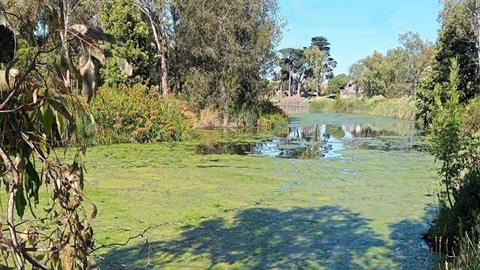Algal blooms at Edwardes Lake

We regularly monitor and analyse the water in Edwardes Lake to ensure the safety and health of our community.
An algal bloom happens when too much algae grows in water, usually because of changes in environmental conditions such as:
- Warmer temperatures
- Too much sun and not enough shade
- Nutrients and pollution washed into the lake
- Poor water movement
- Not enough aquatic plants
An algal bloom affects the overall water quality and harms the plants and animals living in the lake. Some types of algae, such as Blue-Green algae, produce toxins that are harmful to humans and animals. We regularly monitor and analyse algal blooms to ensure the safety and health of our community.
Our analysis has shown that there is no presence of toxic algae in Edwardes Lake. However, algal blooms are still a sign of poor water quality.
What are some of the issues causing algal blooms in Edwardes Lake?
Pollution
When it rains, pollution from roads and properties is washed into drains and creeks and ends up in Edwardes Lake. Sewage spills can also cause wastewater from industrial and residential areas to end up in the lake.
Algae overgrows when pollution brought into the lake contains an excessive amount of nutrients, like phosphorus and nitrogen. Phosphorus comes most commonly from industry and household soaps and detergents, while nitrogen is found in fertilisers used in gardens and farms. Dog poo contains both phosphorus and nitrogen.
Vegetation loss or damage
Creeks, rivers and lakes naturally have plants growing in the water, as well as shrubs and trees around the edge. Plants help to absorb pollution and nutrients found in the water, while trees provide shade to keep the water temperature cool.
Climate change
Due to the rising average temperatures and irregular rain events caused by climate change, it is expected that algae blooms will be more frequent and more intense. Climate change will impact the overall health of the lake affecting plants and wildlife such as frogs, turtles, fish, insects, and many birds that call Edwardes Lake home.
What we are doing to look after the lake
- The Edwardes Lake wetland treatment system filters and cleans stormwater before it enters the lake, while providing habitat for an array of wildlife. Read more about the Edwardes Lake wetland treatment system.
- Algal bloom monitoring and analysis is carried out regularly to ensure there is no toxicity present. Any relevant information about the current state of the lake is made known to the community through signage put up at Edwardes Lake.
- New trees have been planted around the Lake to provide shade in years to come.
- Thousands of plants have been planted around the lake as part of Rewilding Darebin. These plants will help reduce the nutrient build up in the lake.
- The Edgars Creek and Edwardes Lake Task Force was established to improve the health of the lake. One of its goals is to reduce the frequency of algae blooms into the future.
- Read more about How Council is Addressing the Climate Emergency
Things you can do to help preserve the health of Edwardes Lake (and any other creek)
- Always put your rubbish in the bin.
- Clean up after your dog. Always carry waste bags and dispose of these responsibly, either in the nearest bin or in your bin at home.
- Don’t feed the birds at the lake. Bread and other human food offer little nutritional value to birds and pollutes the waterways by increasing its populations and the amount of bird poo in the lake.
- If you find injured wildlife contact Wildlife Victoria on 03 8400 7300 or report a wildlife emergency online.
- Wash your car in a carwash. Washing your car in the driveway allows the cleaning chemicals to enter the stormwater system and then the creek, harming our waterways.
- Check your vehicle for fluid leaks.
- Avoid using herbicides or fertilisers in your garden when it’s going to rain.
- Avoid using the hose to wash the footpath. Instead, sweep it and put the waste in the bin.
- Use phosphate free detergents.
- Care for our indigenous plants, trees, and wildlife, and learn more about their characteristics and benefits here: Darebin's Natural Heritage
- Join groups that take action and advocate for the protection of aquatic ecosystems such as Friends of Edwardes Lake
- Learn how you can reduce your impact and take action on climate change.
Did you know?
Algae occur naturally in all aquatic ecosystems and their presence in healthy numbers is essential for the wellbeing of all the other plants and animals in the water.
- There are around 72,500 known species of algae. That is almost 7 times more than all the known species of birds in the world (which is 11,000 according to Birdlife international).
- Algae are not just green. They come in different colours which are determined by the type of pigment that is dominant in their cells.
- Algae can produce its own food through a process called photosynthesis. This means that in the presence of sunlight, it transforms water and carbon dioxide into sugar (food) and oxygen.
- Algae represent the basis of the food chain as it is a source of food for herbivores (like insects and mollusks) which is in turn food for bigger animals such as fish and birds.